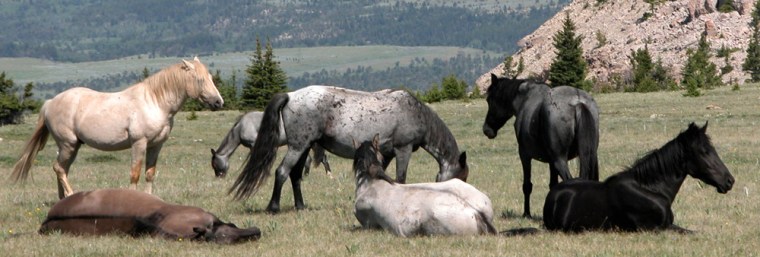The earliest domesticators of horses preferred their steeds colorful instead of color dull, according to a new study that determined breeding by humans caused horses to produce a veritable paint book of coat color shades and patterns.
Since the color explosion began around 5,500 years ago, researchers believe that's when domestication of horses really took off. But why would the ancients have been so obsessed with color?
"Taming and prestige," answered Arne Ludwig, a scientist at the Leibniz Institute for Zoo and Wildlife Research in Berlin.
"Maybe at the beginning, ancient farmers selected for tameness, but they realized very soon that colored horses had a greater value," he explained to Discovery News, adding that old paintings often show kings and other VIP's riding gray, white and other colorful horses.
"Even today, color is important to the economic value of a horse," Ludwig said.
For a study recently published in the journal Science, he and his team studied DNA differences among horse fossils from Siberia, East and Central Europe, and the Iberian Peninsula. They focused on genes responsible for horse coat color variation.
Based on the analysis, the scientists could tell that before 5,500 years ago, wild horses sported rather drab hues.
"Horses of late glacial times were bay (brown)," he said, and even this shade was "more dirty looking, a little bit like a mixture of gray and bay, like Przewalski horses today."
A Przewalski's horse is a rare and endangered species of wild horse native to central Asia. "Wild" horses today, however, are actually feral horses descended from domesticated animals that at some point escaped and adapted to life in the wild.
At the beginning of the fifth millennium B.C., other horse colors emerged, according to the DNA findings. The first modification resulted in chestnut, a reddish shade. Silver, white, dark black, spotted, color-trimmed and numerous more patterns and colorations soon followed.
While it's likely prestigious individuals wanted to show off the most attractive mode of transportation, breeders might have been attracted to colorful horses since color can be tied to certain temperament and behavioral attributes.
"For example, chestnut horses are described as not so full of spirits, which may be a big advantage for their taming," Ludwig explained. "Dilutions and spotting patterns are linked to gene defects, or a less effective mode of operation of receptors, which possibly causes more tame behavior."
The study's pinpointed date for the first major domestication of horses supports yet another research team's findings. Alan Outram of the University of Exeter and colleagues recently studied ancient horse bones, and came to three conclusions.
The first was that horse domestication dates back to the Botai Culture of Kazakhstan circa 5,500 years ago. The second is that "bit damage," caused by harnessing or bridling, reveals these early, domesticated animals were ridden. Finally, traces of horse milk fat on ancient pottery shows the Kazakhstan horse riders were consuming an alcoholic drink called "koumiss" made out of horse milk.
Outram said, "The domestication of horses is known to have had immense social and economic significance, advancing communications, transport, food production and warfare."
Leaders such as Alexander the Great, Genghis Khan and Francis Pizarro later forever changed the world's political landscape by conquering vast tracts of land with mounted warriors astride often colorful horses.
